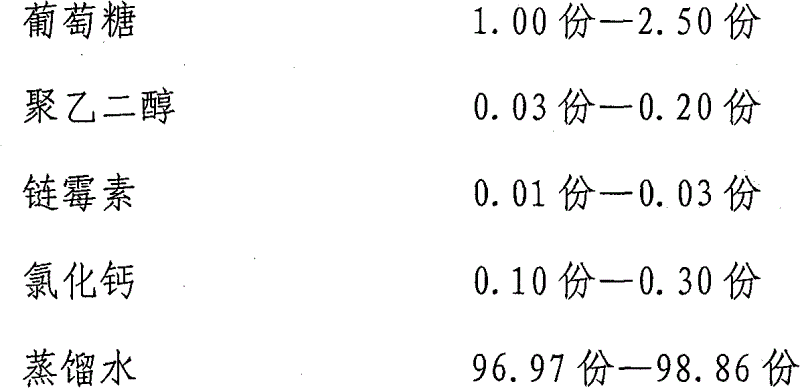Cryoprotective agent for protected vegetable and preparation method thereof
A cryoprotectant and vegetable technology, applied in the fields of botanical equipment and methods, chemicals for biological control, applications, etc., can solve the problems of unstable effect of anti-low temperature measures, high investment cost, time-consuming and labor-intensive, etc. The effect is remarkable, the production efficiency is guaranteed, and the use is convenient.
- Summary
- Abstract
- Description
- Claims
- Application Information
AI Technical Summary
Problems solved by technology
Method used
Image
Examples
Embodiment 1
[0027] First take 1.00 g of glucose, 0.1 g of polyethylene glycol, 0.01 g of streptomycin, 0.20 g of calcium chloride, and 98.69 g of distilled water, and mix 1.00 g of glucose, 0.1 g of polyethylene glycol, 0.01 g of streptomycin, and Dissolve calcium and 98.69 grams of distilled water in 10 grams of distilled water respectively, mix several medicines, then add the remaining distilled water, mix well, and let stand at room temperature for 0.5 hours. The preparation of the present invention is applied to zucchini of the first generation early green, and good results have been obtained. On June 12, 2009, seeds were soaked in warm water to accelerate germination, seedlings were raised in 9cm×9cm nutrient pots, and the preparation of the present invention was sprayed at the three-leaf one-heart stage. The photoperiod was 10h (day) / 14h (night), and the chilling injury index and physiological index of the leaves of the seedlings were measured after 3 days of treatment. Participati...
Embodiment 2
[0029] First take 1.00 g of glucose, 0.1 g of polyethylene glycol, 0.02 g of streptomycin, 0.20 g of calcium chloride, and 98.68 g of distilled water, and mix 1.00 g of glucose, 0.1 g of polyethylene glycol, 0.02 g of streptomycin, and Calcium and 98.68 grams of distilled water were dissolved in 10 grams of distilled water respectively, and several medicines were mixed, then the remaining distilled water was added, mixed well, and allowed to stand at room temperature for 0.5 hours. Early green zucchini experiment: sowing on August 7, 2009, with 1 treatment and 1 control, repeated three times. There were 8 plants tested in each treatment. Residential Area 3m 2 . On October 10, the preparation of the present invention was sprayed, and the control was treated with clear water; on October 17, the preparation was sprayed for the second time. Record output. The test results showed that the yield of the treatment was 2.6kg, and that of the control was 1.5kg, which was 73.33% high...
Embodiment 3
[0031] First take 1.50 g of glucose, 0.15 g of polyethylene glycol, 0.02 g of streptomycin, 0.25 g of calcium chloride, and 98.08 g of distilled water, and mix 1.50 g of glucose, 0.15 g of polyethylene glycol, 0.02 g of streptomycin, and 0.25 g of chloride Dissolve calcium and 98.08 grams of distilled water in 10 grams of distilled water respectively, mix several medicines, then add the remaining distilled water, mix well, and let stand at room temperature for 0.5 hours. Heat-resistant zucchini test: Seeds were soaked in warm water to accelerate germination on July 4, 2009, seedlings were raised in 9cm×9cm nutrient pots, the preparation was sprayed at the three-leaf one-heart stage, and the control was treated with clean water. The temperature and photoperiod were 10h (day) / 14h (night) at 6°C, and the chilling injury index of the leaves of the seedlings was measured after 3 days of treatment. Participating materials in every treatment are 8 strains, repeat 3 times, adopt DPS s...
PUM
 Login to View More
Login to View More Abstract
Description
Claims
Application Information
 Login to View More
Login to View More - R&D
- Intellectual Property
- Life Sciences
- Materials
- Tech Scout
- Unparalleled Data Quality
- Higher Quality Content
- 60% Fewer Hallucinations
Browse by: Latest US Patents, China's latest patents, Technical Efficacy Thesaurus, Application Domain, Technology Topic, Popular Technical Reports.
© 2025 PatSnap. All rights reserved.Legal|Privacy policy|Modern Slavery Act Transparency Statement|Sitemap|About US| Contact US: help@patsnap.com

